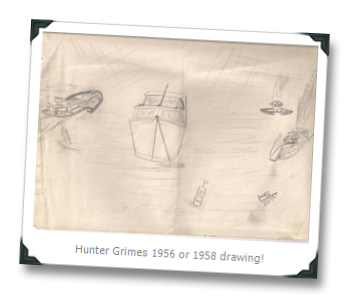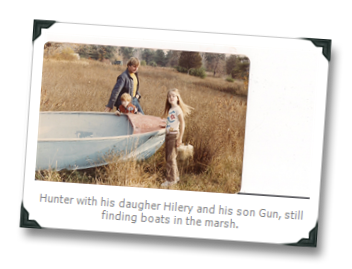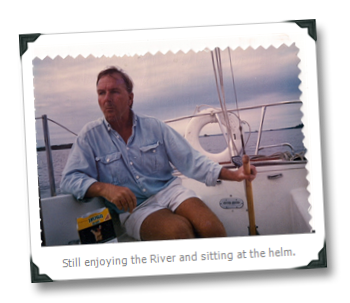“Editor’s Note: This is the second article written by Hunter Grimes about the River. When we heard that Hunter was “remembering his early years” we asked if he would share them with us! Martha Grimes, Hunter’s wife, to help us present this one, she sent several photographs. I personally thank Hunter and Martha, as I remember at age six being allowed to stand on our property’s seawall near Montreal, with paddle in hand, pretend I was rowing out to sea…. ”
Our family moved to the very edge of the River when I was about six. Up ‘til then we had lived over in the village. It would be most profound if I could say that I saw the River and ‘awareness’ happened, but it didn’t, and I don’t even remember how many months we had lived on the water when the big event occurred. All I know is that at some point in time I realized I needed and wanted a boat.
I quickly dedicated myself to a life of general worthlessness, if necessary, in order to ply the waters of the mighty River and be a River Rat. The boat acquisition process started immediately. I then knew, well before anyone else my age, that life’s basic needs were food, clothing, shelter and a boat. I’d insist food to be number one… ( My mother told me I had hollow legs.) Shelter and clothing were forced upon kids. So a boat was the number two need.
Being a very early admirer of Tom Sawyer and Huck Finn, I tried rafts first. A little kid could build a raft, whereas a regular boat was beyond the realm of possibility. My early rafts looked pretty good, being of driftwood boards nailed in a racy thin design. They had to be light so I could move them for launching. Launching always took place in shallow water. Getting aboard was less risky this way as the danger of rollover was eliminated. Sadly, this particular design never gave the desired performance. They would sink on the spot and sit on bottom, refusing to move as long as I stayed aboard.
I eventually started to appreciate hull displacement principles. The rafts got thicker and bigger. Most featured old dock timbers or driftwood logs. The buoyancy of these, of course, had been suffering a-way longer than I had been around.
Some of the vessels in this phase would float to the extent that only my feet got wet. Still, these temporary yachts were big disappointments when it came time for a test ride. The waterlogged components were so massive that I could never affect a proper casting off. I also suspect that I was reluctant to get further away from shore than leaping distance. I didn’t spend a lot of time developing relationships with rafts. I’d bet that even Tom and Huck would conclude that rafts were not intended for the St. Lawrence.
The River home had a huge old boathouse that still functioned well enough that some people rented dock space. There were a few rowboats around that I had access to. I gradually learned to make these craft go generally where I wanted, although I recall my frustration having to stand up in the middle of every stroke to make the oar blades reach the water. It was hard to look dignified and expert rowing like that. Also, none of these boats belonged to our family. Their occasional use by me did not prove to be inspiring.
Then I learned how to get your own boat. You just went around and found one. Then you spied on it for a couple of days. Then you just dragged it home. If nobody came along and reclaimed it, why, you had a boat! This was the time in River history when the old sharpies were becoming unwanted relics. New fangled metal boats were appearing on the scene. The relics were often just allowed to drift up into the marshes or otherwise get abandoned. We always checked the marsh near our house. As if by divine intervention, a boat would often actually turn up there.
A sharpie was a flat bottom boat, pointed at one end, with a cross planked bottom. The ones I came by always were rotten someplace. My evaluations of such boats always began with the, “I could really fix this up.” notion. Just getting one home was good for two days of adventure.
Once home, most of our fix up efforts were intended to reduce bailing time required for further voyages. We tried every conceivable technique known only to small boys. Caulking the many bottom seams like I had seen the men over at the boat works do was much too slow and required skills and tools we didn’t have.
The first attempt to leak proof a sharpie was always to paint it. Paint always improved the potential of a project boat so quickly. We tried hard to dribble paint into the bottom seams. We were always so full of hope when all that paint was on. Alas, when the paint dried those seams reappeared and we went back to the old hassle of who rows and who bails. After the failure of paint as a “leak proofer”, we tried more aggressive measures. Nailing things over the bottom was worth a try. Plywood scrap, boards, sheet metal, canvas…..whatever we would scrounge was pressed into sea duty. While successive efforts involving these and other techniques raised our expectations for boating without bailing, they differed only by the degree of eventual failure and accompanying misery quotient.

We weren’t delicate kids. You might wonder why some water sloshing around in the bottom of an old wooden boat would be a serious problem. If the water was ignored, the bottom would get slimy fast and real slippery. Jumping into such a boat could give you broken bones, strange cuts and cracked skulls. Then your mother would make you stay in for a day or so. Wallowing around in a sharpie with ankle deep water would make your feet get all white with “drownt” skin. Later on the skin would start sloughing off and itching, or maybe stink, and then somebody would try to make you put on socks and shoes. One of the worst things of the water in the boat was the problems it caused when you wanted to go fishing up in Otter Creek. Some fellow kid fisherman would sooner or later knock the worm can off the seat. Then the valued worms would get all pale, limp and skinny. They wouldn’t stay on the hook, even though there was no wiggle left in this condition. Things just were not right when you had to use a worm like that, and the fish seemed to add their disapproval, so that we ended up quitting, with some kid whining about wanting to go home.
As with most problems in life, there evolved a solution for the problem of leaking sharpies. I don’t recall the circumstances, or the particular boat that was the subject of this break-through. Without further ado, I tell you that black roofing tar will make any boat stop leaking if you get enough on! River Rat kids regarded this goop as if it were soft black licorice. It was slathered on leaky boat bottoms like frosting on a cake. To use it was a sure way to run afoul of moms who were determined to keep our hides clean, if not our clothes. It was all worth the risk. Boats treated this way didn’t even require a drying period. Adventures afloat could begin immediately after application. Bailing cans were still included as standard equipment, along with the boards which served as paddles or auxiliary power to friction taped oars. The can was good for removing rain water and had to be ready when too much tar got rubbed off on rocks and gravel. Looking back on it all, I suppose a permanently leak proof boat was a lofty, unattainable thing for kids to work for.

The leaky boats surely played a major developmental role in our River kid lives. Mostly, they kept us slowed down and close to shore. We didn’t venture further than shallow bays and marshes, or up in Otter Creek. If we’d had boats that didn’t leak, we would have been out on the big part of the River where the water was over your head and the waves were big, and where steam ships might run over you. None of us would have lived to see ten!
By coincidence, we did get to be ten and at the same time that the boat industry was really shifting gears. Aluminum and fiberglass were becoming the hull materials of choice. Names like Crestliner, Aluma Craft and Arkansas Traveler seemed to eliminate the likelihood of seeing a brand new Lyman, Barbour or Thompson on the River. I can still recall the special comfortable look they had with those graceful lap strake hulls and glowing varnished interiors that smell sweet on a warm summer day. They could only endure as the collector items that they are today. They required care. They didn’t take well to oil and gas in the bilge, to lack of paint or being left out in the weather. And they certainly didn’t respond favorably to the adventurous intentions of River Rat kids.

Around our house it is possible that we didn’t contribute enough real work to suit my father since we were spending so much time messing with old sharpies. Maybe he got tired of watching the same old fiasco over and over. For whatever reason, he came home one day with a new aluminum boat. It was a 12’ Arkansas Traveler that could serve as a rowboat or accept a small motor. It did neither ideally, and motors were to be a later development anyway. Nothing would have diminished the exhilaration that greeted the arrival of this little boat. She quickly became one of our gang, with a complimentary, yet unique, personality.
She was nimble enough and quite safe since she did have that new styrofoam flotation under the three seats. Best of all, she did not leak a drop! We had limitless fun with that boat, year after year. Two kids could fit on the middle seat so that each could man an oar. This always prompted rowing contests which resulted in spasmodic directional progress, and then spinning in tighter circles as the weaker oarsman became less valiant. This same style, with a co-operative effort, could make the boat surge along so exuberantly that we were sure we were modern day Vikings.
I now know that it was a homely boat. However, it was the first boat I met that was a willing partner instead of a dependent out to frustrate and consume a kid. I could perch in the very bow and paddle it like a canoe to be an Indian or a voyageur. I could stand up in the back and scull it with an oar. I could watch things ahead better. I could, and usually did, sit on the middle seat at the regular oar station and pull away steadily like a kid with some place to go and things to do. It got so that boat was like a part of me. I didn’t know I loved it. I would do anything to have that boat today.
The reason I don’t have it today, as you might guess, is that it got to leaking. For quite a while it was growing older with us admirably. But then, we got bolder and rougher. One spring we got the bright idea of using the dauntless midget Arkansas to help us hurry up the start of boat time. The ice in the bay had turned to that gun metal blue and started to honeycomb. We put the bow up on the ice, then jumped up and down until the ice gave way. We did it again and again with the resolve of pubescent icebreakers. After a while, the poor little girl developed all sorts of hurts that started the leaking. Even tar would not stick to it. Only expensive welding would restore her integrity, but that seemed to make the metal more brittle and a new crack would appear near the old after only a little more abuse. After some years of this treatment she just disappeared one night. With the floatation long since gone and lots of leaks to contend with, we tended to keep her half pulled up on a small wood ramp. I suspect she just slipped away and sank. By then we had moved on to other boats that should not leak and had other attributes.
Those were rich days! Still, I am sad about a couple of things. For some reason that important little boat was never named. That seems cruel now. And I have found out that all boats will leak some day………..more when you love them less. It is hard to know all this stuff when you are a kid and there is still time.
By Hunter Grimes
Hunter Grimes served in the Navy from 1966-1970. In 1968-70 he was with UDT 21 and Navy Seals. He is currently owner of Diverse Construction Group, LLC. He attended SUNY Oswego, University of Alaska at Fairbanks and Syracuse School of Forestry. Hunter is certainly a genuine River Rat – a reliable term given for those who spend their lives on, in or under the River. In 1989 Canadian author, Shawn Thompson wrote his book, “River Rats: The People of the Thousand Islands”. Page 68 has the Hunter Grimes story. Hunter and his wife Martha have devoted their lives to their community, both being recognized for their volunteer efforts and leadership.
Editor’s Note: In November 2010, we published the first Hunter Grimes article: Blue Lips and Goose Bumps. I explained then that I had served on the Save the River Board of Trustees in the 1980s, I knew Hunter as the president and a committee man for the organization. When I heard his River stories, I realize he brought a wealth of experience on River issues to the table. We are lucky to have Hunter and Martha as River neighbors.